The Bagpipe Society
Summer 2019 Articles
Please note, we are planning to improve the formatting of the below!
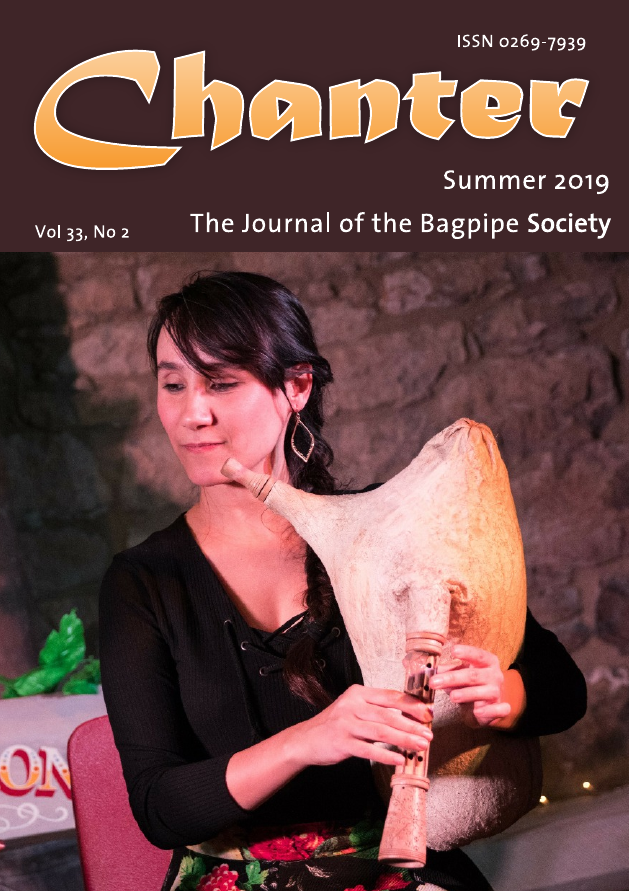
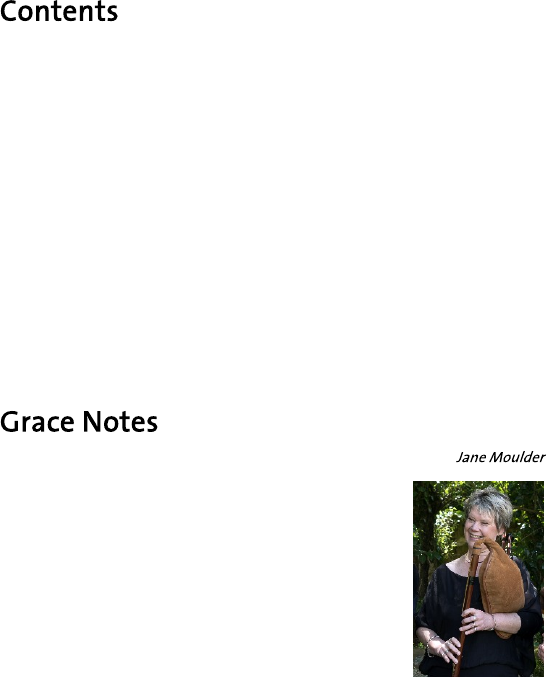
Grace Notes
3
Bagpipes Go to Somerset - Dave Faulkner and Rachel Hill
5
Beauty in Tears - Dave Rowlands
8
The Macedonian Gajda - Part II - Fabio Resta
14
Experiments with Elder Pipes - Paul Martin
18
Chanter Reeds & What the Chanter Reads - Marius Lutgerink
25
Tools of the Trade: The Octogonalizer - Mike York
33
Reviews: The Long Century by Dave Rowlands (book)
37
Across the Water by Dave Rowlands (book)
39
Antithesis: Branschke Armstrong Duo (cd)
40
In the Bag - Michael Vereno
41
Grace Notes
By the time this edition of Chanter arrives through your letterbox, we will either be just about to go to the Blowout or have just come back. The Blowout is a fabulous weekend and a rare occasion in my calendar where everyone I meet is talking the same ‘language’ – a love and understanding of pipes. Whilst it is becoming more and more common to find pipes being played at various folk and music festivals, sadly the instrument is still seen as something of a curiosity. For me, the Blowout will be quickly followed to a visit to Le Son Continu and then, at the beginning of September, a trip to North Yorkshire for Medieval Music in the Vales – yet more bagpipes!
Welcome to the new members of The Bagpipe Society. The membership is slowly increasing and looking very healthy at the moment and it is interesting that many of the new members are from North America and Europe. I would be very interested to hear about their experiences with bagpipes and whether or not the situation is the same as in the UK – small pockets of players dotted around the country, few chances to see pipes being played on stage and an ignorance about anything other than the Great Highland Bagpipe. (I still get asked as to what the instrument I’m playing is, which is then met with surprise when I explain that it’s a bagpipe ….. but it’s not Scottish!)
Wherever you are in the world, I hope your summer months will be filled with music, dance and bagpipes.

Dear Jane,
I’m grateful to Terry Moylan for telling us the background to the piping pig mistakes perpetrated by the Irish postal service An Post. My text was clearly sympathetic to that possibility: “… please let it not beNa Piobairí Uillean, who I hope are equally annoyed about this …”, and I’m not at all surprised to hear that the error was completely beyond their control. I’m also grateful to have my suspicions about the pig’s details corrected or verified and revised most competently. I’m all for the clarity we can achieve by collaborative discussion. Of course, I’m not an authority on Irish uncial and never claimed to be – just made a passing comparison that evidently got misconstrued. Did I suggest thatIconsidered the pig’s bagpipe closely resembles the Scottish bagpipe? No. What I wrote, with an ill-concealed ironic ‘wink’, was: “Aw c’mon. If anything, even to the untrained eye, the stamp pig’s instrument might more closely resemble the Scottish instrument.” To the untrained eye … might. But it does more closely resemble that than the Uilleann instrument, doesn’t it?
I was surprised to read my discussion described as: “… vehemently expressed, bullet-pointed, foot-noted outrage.” I defend bullet-pointing the text to formalise the discussion as segments and foot-noted so that sources could be – according to good academic practice – checked. However, I don’t recall a sensation of outrage as I wrote, which had there been such, I think might it have been expressed in a rather less orderly fashion: perhaps indignant and lacking organisation, rigorous reference citing and question marks where appropriate. Outrage is not usually represented by observation, fact-finding and speculation. The article was not an outpouring of outrage, just straightforward analysis and inquiry, and in response, Terry provided answers and clarity, which is just what was needed.
James Merryweather
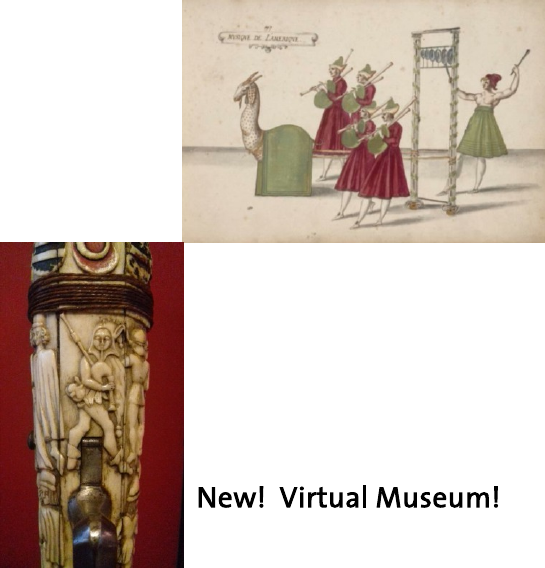
Dear Jane
Today I was down to a bookshop in town, with a feeling that I might find “something”. The last time this happened I ended up with a book of Baroque duets, the Scots Guards Book 1, and the complete Country Marriage by Hottetterre. This time I was not disappointed. In a book detailing Baroque music I found the following. This image is from the “‘Le Grand Bal de la Douairière de Billebahaut’
(The Grand Ball of the Dowager of Bilbao) by René Bordier, performed in February 1626. The set and costume designer, and artist, was Daniel Rabel, (1578-1637). The pantomime showed off the peoples from the known and unknown world. The image is labelled as the entrance of American music. The musicians pre- ceded Atabalipa, King of Cusco. Given that Rabel was French, designing for Spain, but is known to have been influenced by German caricature art, the bagpipes could be from anywhere!
Dave Rowlands
Thanks to Paul Haynes who has been sending me some photos he’s taken of bagpipers from various sources. One is featured on the back of this edition and another lovely little piper is shown here. From the Wallace Collection in London, the caption says that it dates from the second half of the 15th century and is found on the tiller of a cross bow – the coats of arms are from the South Tyrol and Bavaria.
You may remember the article by Patrick Burbaud which was printed in Chanter Vol 32, No 3 concerning the historical survey of the boha. Patrick detailed the different designs and uses of pewter on the instrument and the article illustrated the various examples of inlay on the connectors, chanters, blowpipes and bruniders. His work has now extended further and he, in association with the “Bohaires de Gasconha”, have just launched a new website and virtual museum. The website has pages dedicated to surviving historical instruments, the musicians, reed design and construction, an analysis of the different aspects of the pipes as well as lots of photographic examples. The site is well worth a visit. http://museedelaboha.fr/

Bagpipes Go to Somerset - David Faulkner and Rachel Hill
As reported in the Winter, 2018 edition of Chanter, Halsway Manor is fast becoming the established venue for bagpipe courses in England, with a wide variety of piping themed events taking place. Here’s news about two of them.
In February this year, the Bagpipe Society sponsored Dave Faulkner to run a beginners’ course as part of the annual Bagpipe and Hurdy Gurdy weekend at Halsway Manor in Somerset. Whilst there, Dave went to a local school along with Joel Turk, who plays gurdy. This is his report:
Crowcombe School
The beginner’s workshop at Halsway Manor was supported by the Bagpipe Society. To compliment this activity, we did an introduction to bagpipes at Crowcombe Primary School just down the road from Halsway. To make it even more fun we invited Joel Turk a Hurdy-Gurdy player along to demonstrate his instrument too. We worked with 60 children from the Key stage two (7 to 11) part of the school. We demonstrated the instruments, told the children about the history of the instruments and about our lives playing them. The children asked lots of questions.
We taught everyone how to play simple parts to accompany the pipes and hurdy-gurdy and three children joined the band on violin and guitar to dem- onstrate this. So, they got to play with pipes and gurdy and everyone learnt that making music can be accessible!
We then taught the children and staff a simple dance and everyone danced to the sound if pipes and gurdy. More questions and answers and then we said our goodbyes.
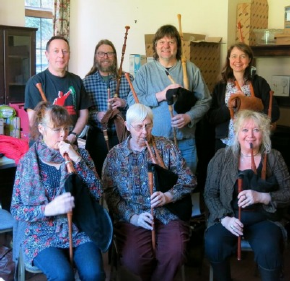
Beginner’s pipe workshop
The beginner’s pipe work-shop had 8 attendees. Three had brought their own instruments but for those without, we used the Bagpipe Society’s six mouth blown student sets in G. I’m pleased to report that all sets were working well.
All the people who came had previous musical experience and played other instruments. One person had had the course bought for her as a Christmas present! On day one we had 5.5 hours of tuition and on day two 4.5 hours. That’s a lot and we filled our brains!
Over the two days we learnt about parts of the instrument, blowing, drones, tuning, posture, finger placement and fingering, principles of gracing and vibrato, types of pipes available, choosing an instrument, had many discussions, and bigged up the Bagpipe Society. I provided ear plugs for all that wanted!
We used four pieces of music over this time - all of which had some challenge or reason for being used built into them. At the end of our time we could play them all! In order of progression we used, the Farmer’s Daughter, Singen einmal hundertzehn gemeinsam, song from Le garçon jardinier and a Galician gig.
The Farmer’s Daughter is a simple waltz used as a teaching tune from the Limousine, the German tune is a round that can be played in either G mixolydian or G minor, Le garçon jardinier introduces Bb and the Galician gig is good for scales and gracing! We also spent some time trying out the Bagpipe Society’s Small pipes. At the start of the course we made a list of outcomes and targets that the students wanted to achieve, mostly were to do with having a go and getting better! We achieved what we set out to do and everyone seemed to go away happy. Three people said they would now like to buy some pipes and two would like to come to the Blowout.
I always learn something from teaching pipes and I had a fantastic time with the students who stuck it out and worked really hard. A highlight for me perhaps was playing a dance session with Olle Gerris (pipes), Gilles Chabenat, Francesco Giusta, Joel Turk (on Hurdy Gurdys) and Steve Turner (on accordion) – Saint Chartier 20 years ago!
Dave Faulkner
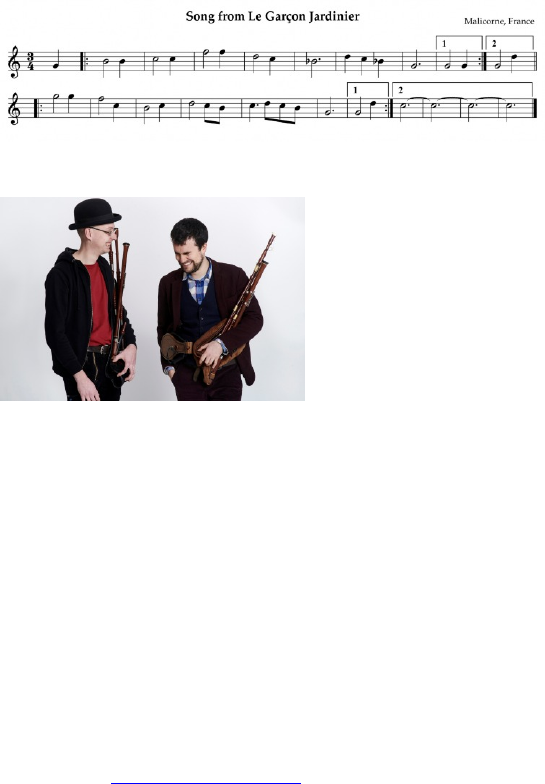
Bagpipe Ensemble Weekend – with Callum Armstrong & Matthias Branschke
Callum Armstrong and Matthias Branschke will be familiar names to many readers, though perhaps not to all. Callum came to my notice when tutoring at Halsway’s 2018 Halsway Pipes and Hurdy Gurdy Weekend – and what an impression this extraordinary young musician made, not just on me but on his students too; “I think he’s a bit of a genius” said one Paul James (Blowzabella)!
Speaking after the event, I invited Callum to return to Halsway to run his own teaching weekend; he in turn suggested a project involving Matthias
(already on my radar for his work as a duo with harper Merit Zloch), and as a result I’m delighted to be welcoming two of Europe’s most innovative and accomplished bagpipers to the Manor in October this year. Callum & Matthias have chosen to lead a Bagpipe Ensemble Weekend, an intensive weekend focused on playing bagpipes in an ensemble setting. The course will cover writing counter melodies and harmonies, groove, and tips on how to play in a group. The weekend will feature a solo-duo concert from the tutors on the Saturday evening, together with time also to relax, play informally and socialise.
The weekend is intended for Intermediate / Advanced level pipers, with pipes – of all varieties – in the keys of G & D. 20 places are available. We’re asking that you tell us about your pipes when booking
Halsway Manor Bagpipe Ensemble Weekend, Fri 25 – Sun 27 October 2019 Prices: Full board £165 - £240 Discounted rates for camping (£155) and non- residents (£145) www.halswaymanor.org.uk
Rachel Hill, Programme Manager at Halsway
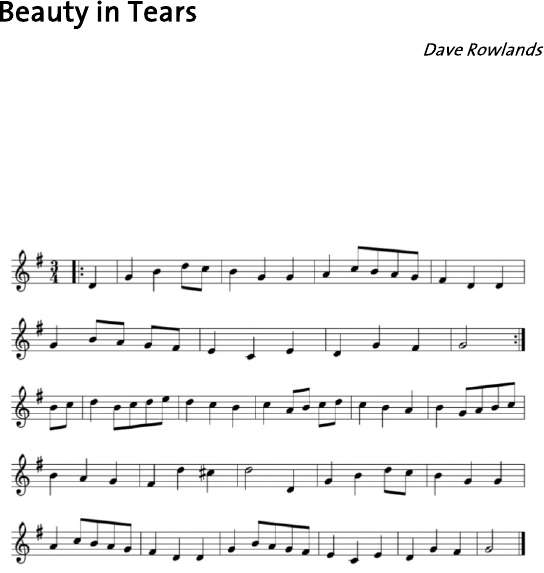
Beauty in Tears - Dave Rowlands
I was idly leafing through an anonymous C19th manuscript on the Ralph Vaughn Williams library website, when I came across a tune title for a pipey little waltz that spoke of loss, “Beauty in Tears”. I had not seen it before but when I hummed through the tune I instantly recognised it, so I decided to spend a little time researching it and its possible origin. The tune itself is almost all in the single octave with only one note needing adjustment to work on single octave pipes. It has some piping resonance as we shall see and it has been recorded by Irish piper Tommy Reck. It would appear that the tune is also known as the “Ash Grove”. Several Hymns have been written to this tune, a thanksgiving hymn “Let All Things Now Living”, composed in 1939 by Katherine Davis and a hymn, long before the 20th century, under the title “The Master Hath Come” by Sarah Doudney (1871).
The first known English-language version of “The Ash Grove” was published in 1862, in Volume I ofWelsh Melodies, with Welsh and English Poetry, compiled by the harpist John Thomas, with Welsh words by John Jones and English words by Thomas Oliphant. The first verse of this version is incorporated into a different interpretation by the English dramatist and translator John Oxenford.
Oliphant lyrics, first verse
Down yonder green valley, where streamlets meander, When twilight is fading I pensively rove Or at the bright noontide in solitude wander, Amid the dark shades of the lonely ash grove; ‘T was there, while the blackbird was cheerfully singing, I first met my dear one, the joy of my heart! Around us for gladness the bluebells were ringing, Ah! then little thought I how soon we should part.
Oxenford lyrics, first verse
The ash grove, how graceful, how plainly ’tis speaking The harp (or wind) through it playing has language for me. When over its branches the sunlight is breaking, A host of kind faces is gazing on me. The friends of my childhood again are before me Each step wakes a memory as freely I roam. With soft whispers laden the leaves rustle o’er me The ash grove, the ash grove alone (again) is my home.
The Fiddler’s companion website points us to the tune “How Shall We Abstain from Whiskey.” “Cia mar is urra’ sinn fuireach o’n Dram.” It is also known as “The Legacy”. It goes on to inform us that the editor of Fraser’s “The Airs and Melodies Peculiar to the Highlands of Scotland and the Isles”,1874"…. “had great pleasure in asserting his country’s claim to this melody lately introduced as Irish, under the name of ‘The Legacy’, supposed new, whereas it has been current in the north for sixty years as the composition of John MacMaurdo of Kintail, since emigrated to America" (Fraser). “The editor has already attempted to rescue this melody from a claim of its being Irish. The author, John MacMurdo or MacRae of Kintail, was one of the most sentimental composers of song ever known in the north, and several others of his will be pointed out in this work. He observes, in the words to this air, that though his wife may sometimes brawl at him for consuming, in convivial excess, his means of supporting her and his young family, he must devote a part of it to social friendship, that often links men closer than chieftainry or relationship”.

His ire at the possibility of this tune having been usurped by the Irish may come from its appearance in O’Neill’s Dance Music of Ireland 1850 melodies,
(p113, no. 635), where it is claimed as a work by T O’Carolan. However, this has been disputed by Donal O’Sullivan, who did not include it in the biography “Carolan: The life, times and music of an Irish Harper”, 1958.
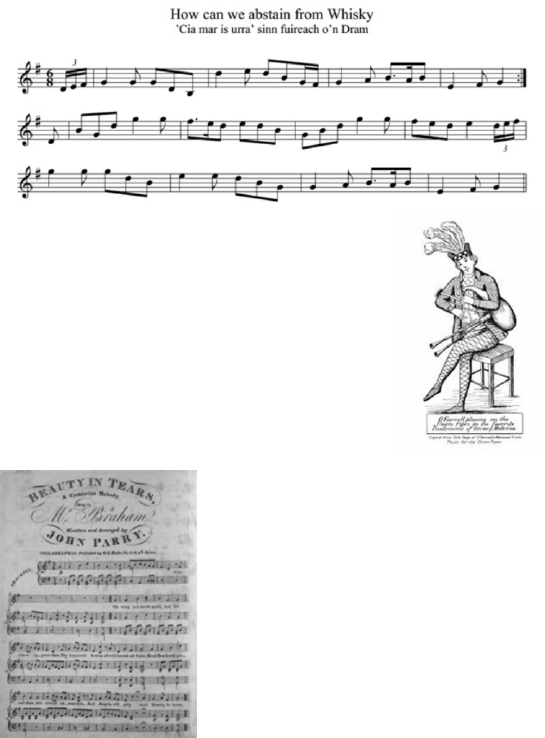
A further Irish link is its appearance as Llewellyn in O’Farrell’s Pocket Companion for the Irish or Union Pipes, vol. III, 1808. It was obviously a popular and well- known tune. O’Farrell was a piper and publisher. He played the Uilleann pipes in the long running pantomime “Oscar and Malvina” following the death of the original piper, Dennis Courtney.
John Parry, known as Bardd Alan, published the song, “Beauty in Tears” in around 1811, for the singer John Braham. It is certainly reviewed in “The Repository of arts, literature, commerce, manufactures, fashions and politics”, Volume 10, published in 1813, by Rudolph Ackermann: “Beauty in Tears, a Ballad, sung by Mr. Braham, in the Grand Romance of Lodoiska, written and arranged by John Parry.”
Oh weep not, sweet maid, nor let sorrow oppress thee, thy innocent bosom should banish all fears; Kind heav’n will protect thee, fair virtue caress thee, And angels will pity such Beauty in tears.
He published it at least twice more, once in 1817, in his publication The Vocal Companion, and again as a tune in Two Thousand Melodies, in 1839, wherein the tune “Cease your funning” can also be found. Parry’s inclusion points to a Welsh link, and the tune is included in Gow’s Strathspey Reels (book 4, pg. 24), as “Sir Watkin William Wynn.” The air is considered by some to be an early 18th century melody from Wales, perhaps because it is attributed to that country in Gow.
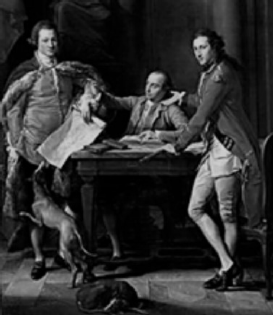
Sir Watkin Williams-Wynn (1772-1840), 5th Baronet of Wynnstay, was a north Welsh gentleman and land proprietor who raised a troop of cavalry that saw service in Ireland during the Rising of 1798. The troop, called the Ancient Britons fencible cavalry, “were at all times prominently conspicuous for the rigorous execution of any orders for devastation, destruction, or extermination”. They were marked for it by the rebels, and in the course of the rebellion they were cut to pieces almost to a man, (Mitchel & Mac-Georghegan, History of Ireland: From the Treaty of Limerick to the Present, 1869).
The regiment was disbanded in April,1800. He was Member of Parliament twice and appointed Lord Lieutenant of Merionethshire from 1793- 1830. In March,1814, Sir Watkin went to France as Lieutenant-Colonel Commandant of a Provisional Battalion of Militia composed of men from the Denbigh, Derby, Hereford, Westmoreland and 2nd West York Militia. Unfortunately, when they disembarked, they found that hostilities had already ceased and Napoleon defeated. Mortified, they reportedly consumed copious amounts of drink. Williams-Llyn (on the left of the picture) was the wealthiest Welshman individual in Wales, with extensive estates in the north of the country. He spent much of his fortune on buildings, on gardens and on collecting art. He loved music and the theatre, but he had a particular passion for the visual arts. He had musical connections and was patron to Parri Dall. John “Blind” Parry -, Parry (Parri Dall or Blind Parry) was born in about 1710 on Pen Lion, Caernafonshire, Wales. Blind from birth, as a child he found a patron in the Griffiths family who initially gave him a Welsh triple harp and support for mastering it.
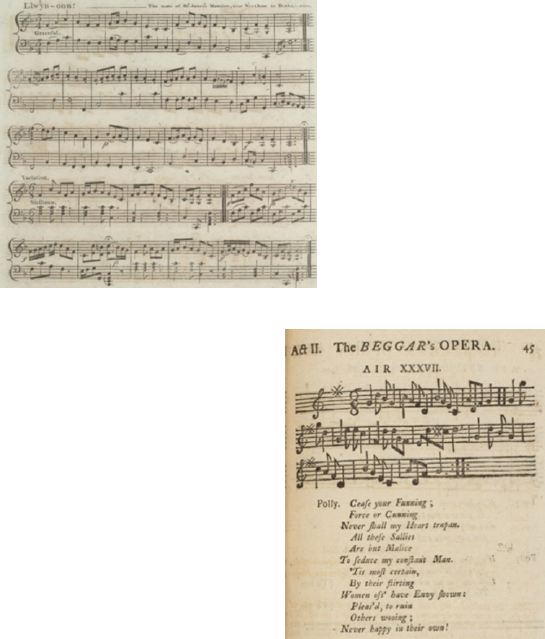
He later became harpist to Sir Watkin Williams-Wynn at Wynnstay, Ruabon, and where he perfected his baroque composing. Willams-Lynn periodically brought him to his residence in London bringing his music and playing to a wider audience. In fact, his harping was admired by George Frederich Handel (who resided in England as court composer to George II), and Parry played the great composer’s Concerto in B flat at Hickford’s Great Room in Brewer Street, Soho. Parry died in 1782. In fact, the earliest Welsh printing is not until Jones’s Bardic Museum (1802), as “Llwyn-onn”, where it is given that it was named after ‘Mr. Jones’s mansion near Wrexham’. Robin Huw Bowen says it is played in the form ‘theme and variations’, a form popular with Welsh harpists of the early 18th century. The associated song tells of a sailor’s love for “Gwen of Llwyn”. At the end of the song, Gwen dies, and in one version of the piece, the writer talks about him mourning and that she is lying " ’neath the shades of the lonely ash grove”.
It is conceivable that Parri Dall heard the tune in his childhood, as it is the tune to “Cease your funning”, appearing in the Beggars Opera in 1728. It has also been linked to the tune Constant Billy, now used for morris dancing but seemingly first printed by Young in the 1726 edition of the Dancing Master. Intriguingly, “Cease your funning” contains the line “To seduce my constant man”, whether there is a lyrical link to Constant Billy I am unsure of at this point. Given below from The Adderbury morris tradition.

Oh, Billy, my constant Billy, When will I see my Billy again? When the fish fly over the trees, Then will I see my Billy again. Oh! my Billy, my constant Billy, When shall I see my Billy again? Billy again! Billy again! Billy again! Billy again! Oh! my Billy, my constant Billy, When shall I see my Billy again?
Frank Kidson, the antiquarian, also associated the tune with the song “When high hill and lofty Mountains”, No. 243 in Apollo’s Cabinet, Pub J Sadler, 1757, Liverpool. The VWML documents point to a song published by Henry Carey, “Beauty in Tears, or Lesbia’s Squirrel”, in his work “Poems on several occasion”, London,1713.
His biographical website tells us, that “two major music historians of the period, Sir John Hawkins and Charles Burney, have left testimonies to Carey’s skill in melodics”. Hawkins (A General History of the Science and Practice of Music, 1776) says of Carey, “though he had little skill in music, he had a prolific invention, and very early in his life distinguished himself by the composition of songs, being the author both of the words and the music.” It continues:- Carey’s claim to fame lies in his literary works, but in the early part of his career he thought of himself primarily as a musician, and after these early successes, he set about to increase his musical skills. He took lessons from Olaus Westeinson Linnert, about whom little is known, then from two better-known masters, Francesco Geminiani, the renowned violinist and composer, and Thomas Roseingrave (1688-1766). Roseingrave was the son of an English musician of some repute and later established a reputation of his own. In 1709 his father sent him to Italy to study, and on his return to England in 1715 he became known as a supporter of the works of Domenico Scarlatti, with whom he had formed a friendship while in Italy.
With two such Italianate influences in his background, it is not surprising that Carey’s musical works display the characteristic Italian style of the early eighteenth century. Melody was his forte. Sprightly tunes, usually simple but rarely trite, are to be found in all his works.
During the 1720s Carey worked irregularly for Colley Cibber at Drury Lane, adding songs to old productions and providing music for the ballad operas which proved successful with the public afterThe Beggar’s Opera (1728). His most famous tune and lyric is “Sally in our ally”, still used and sung today. Given the society in which he moved and worked, I find it highly likely that he composed the tune to Beauty in Tears (pub 1713), and possibly modified it for The Beggars Opera. He may, however, have modified the tune Constant Billy (pub 1726), retiming it from 6/8 into 3/4. We will never know. As it was common for tunes to be used for new songs, the attribution to Constant Billy may have occurred in the intervening years from 1713 to 1726.
Quite what is alluded to in the original song is questionable and I leave the reader to investigate further. However, the last song in this investigation might give a pointer. Whether by intent, or by the action of fate, the tune is used for the bawdy schoolboy ballad, “The Mayor of Bayswater”, a song which draws attention to the genital topiary of the daughter of the senior civic dignitary of the fine town. There is a version from the west of Scotland, giving an international feel….
“In yonder green valley there lived a wee Tally, and the hair on her dicky-di-do hung down to her knee”
*(“Tally” = “Italian”, a common slang term, quite affectionate; a “tally shop” is one typically kept by Italians, such as one selling fish and chips, ice cream, etc.).
The tune has travelled far and wide and has been used for some interesting songs at both ends of the social scale. It has entered the harp tradition, the piping tradition and the rugby tradition. I have not been able to prove that Henry Carey wrote it but I do feel it is quite likely. I have been able to link parts of its journey; where the change to the Ash Grove came from, the fact that a harper, Perri Dall, played it may have caused its association with O’Carolan, a possible link from the early C18th with the transmission by Perri Dall to the Welsh Tradition and further possible links with John Gay’ Beggars Opera. There is also the association with O’Farrell.
If Carey with “little skill in music” did write this tune it is a big legacy and, prophetically, the tune has the name “The Legacy” associated with it as well. Below is the tune as I found it, which is very similar to one transcribed from the playing of Uilleann piper Tommy Reck.
The Macedonian Gajda - Part II - Fabio Resta
In Chanter Winter edition, 2018, Fabio gave an overview of the instrument and its history. In the second part, Fabio explores some of the repertoire.
Modes, scales and dances
Almost all the popular melodies in Macedonia belonging to theizvorna (rural) genre possess a plagal ambitus: they rarely rise above the fifth degree and descend beyond a fourth below the tonic. Many instruments have characteristics that clearly underline this area, for example the gajda tonic is found by closing the four holes of the left hand alone, with which an extension of a fifth is obtained.

Gajda music is based on three scales, each of them consists of five sounds (plus four under the tonic). The first is characterized by the presence of a major third, the second by a minor third, the last one by a minor second and major third (Makam Hicaz).
Below is the list of the three main scales used in the music for Gajda in Macedonia with the nomenclature of the modes which are also used Byzantine Orthodox chant and in Turkish Makam. In the previous article there was a fingering chart to illustrate how to perform the scales with the various Balkan bagpipes (Macedonian, Bulgarian or Greek Gajda). Most of the music repertoire for Gajda can, however, be performed with any bagpipes and below I give musical examples for each of the scales. Normally in the bagpipes of the Balkans all three scales share the same tonic, which is normally A or Bb in Macedonia, G or D if you play the mainland Bulgarian djura gajda and low D or E for kaba gajda of Rhodope mountains region. To play these dances with another type of bagpipe it is preferable to move the tonic a tone above and adjust the drone when playing in minor and in the mode of Hicaz. The examples are therefore written in C for dances in major mode and in D for dances in minor mode or Hicaz.
Oktoechos’ eighth mode (Osmiot Glas) - Makam Rast
Just play as a major mode from C if you play a C bagpipe or from G if you play a G bagpipe. You can also try to play your bagpipe as a plagal instrument with tonic found on fourth degree. If you play a C bagpipe tonic is F, if you play a G bagpipe tonic is C. Try adjusting the drone to the fourth degree of your bagpipe. Pravoto Lesnoto is a dance that makes use of this kind of melodic organization but it also works with Crnogorka.
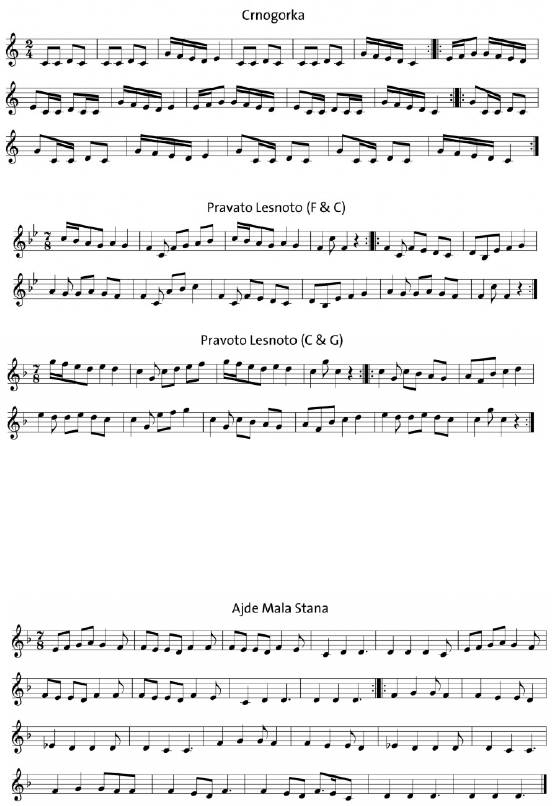
Oktoechos’ First and fifth mode (Prvot i Pettiot glasovi) - Makam Hüseynî- Uşşak
This is one of the most common modes found in Macedonian folk music.
In the final descending cadences a lowering of the second degree by a semitone may occur (Ajde Mala Stana). Play this mode from D on a C bagpipe and from A on a G bagpipe. Adjust drones.
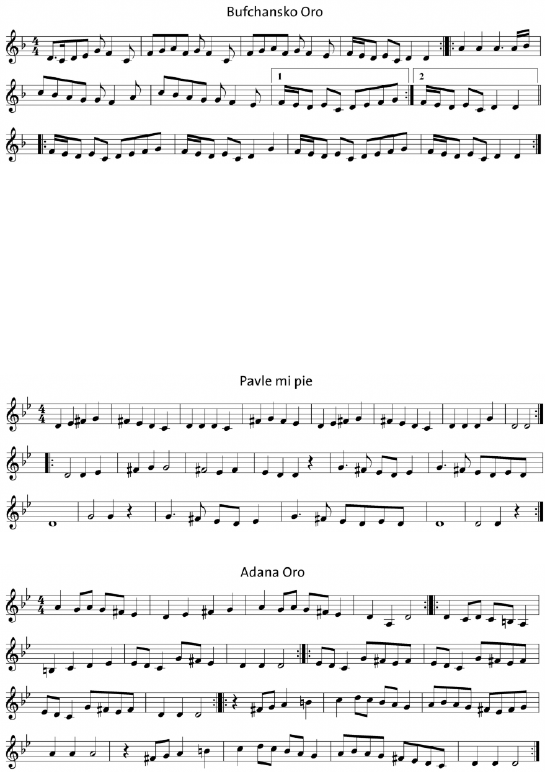
Oktoechos’ second and sixth mode (Vtoriot i Šestiot glasovi) - Makam Hicâz
The use of the augmented second interval (between second and third grade for the Hicâz makam) was one of the means of expression in the West to paint the Other, more particularly Hungarians, Turks, Arabs. These scales were widely used during the course of the nineteenth century by several composers, among many Bartok in Romanian dances, Dvořák in Slavic dances, Brahms in Hungarian dances and Liszt in Hungarian rhapsodies.
This mode has a minor second between the first and second degree and a major second between the second and third degree.
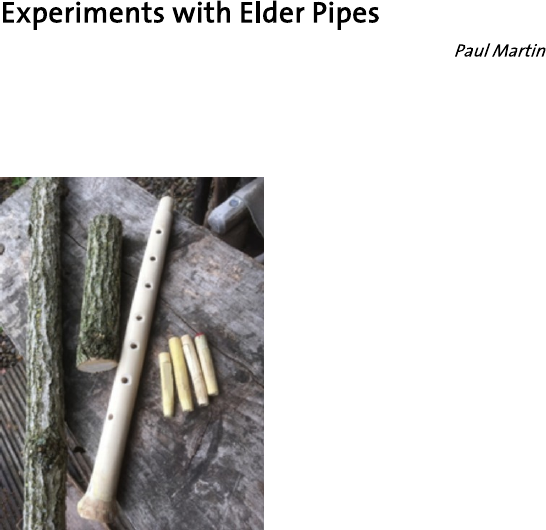
Experiments with Elder Pipes - Paul Martin
Around late Spring last year I began to try to make a reed pipe from Elder (Sambucus nigra). Why? Here’s some background information on my interest in single reeded bagpipes. Even though the majority of the bagpipes I’ve played in my life have been double reeded (referring to the reed in the chanter), the Highland Bagpipe, Border pipes of varying sorts, Uilleann, and Northumbrian Pipes, the sound made by a single reed has had a special attraction for me.
My first experience of hearing a single reed bagpipe was at the Zywiec festival in the south of Poland in 1998. I didn’t realise at the time, but I was hearing the Dudy/Gajdy of the southern border region between Poland and Slovakia. The sound was soft, yet still had volume and a melancholy almost vocal note. The bagpipes also retained features of the goat that it had been made from, and in the voice of the chanter, there was also something goatlike…….
Not long after, I found myself in Australia listening to Linsey Pollack playing Macedonian Gaida at Woodford festival. The music fascinated me and I bought Linsey’s CD and accompanying book of Macedonian folk music and tried to play it on my pipes and a mandolin. The seed was sown and I began to look out for an opportunity to buy my own Gaida.
Two years later I bought my first single reeded bagpipe at a festival in Hungary from a Bulgarian Gaida player, Krasimir Dimitrov. The inevitable reed problems ensued until a trip to Varna where some kindly Gaida players swapped my reed for one of theirs. It was a composite reed, the body being clear plastic and the tongue fashioned from a clarinet reed, the original reed being made entirely from wood. This reed worked very well until it was accidently damaged.
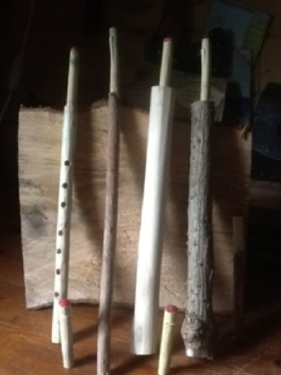
I attempted to replace the cane tongue of the reed and to my great surprise it worked! During this period I learned that originally all the reeds for a Gaida and indeed other East European bagpipes were made from small tubes of Elder. Indeed, other wind instruments I was coming across, Shepherd’s flutes such as the Fujara, Tilinko, Kaval, Furulya, were often and usually made from branches of the Elder tree. I also became aware of a resurgence in interest in a single reeded pipe from Britain, the Welsh Pibgorn, and bagpipes made along the same idea of a hornpipe on a bag. Alexey Zhivaykin a friend who plays various reed and stringed instruments in his band Krystal Balalaika, sent me a Russian hornpipe, a Zhaleika.
It was now clear that there had been and still is a huge family of single reed pipes, and bagpipes, forming a common pan European culture of using the Elder tree to make music. As a tree surgeon I was familiar with Elder, its appearance, bark, flowers, berries. Also the folklore attached to it, asking permission of Old Mother Elder before cutting a branch, and the uses for the flowers and berries in wine and syrup making (including one explosive bottle of Elderflower champagne!). The reason that it is used for making pipes is that the centre of the branch has a soft pith which is easily removed and provides either a ready- made bore or a guide hole to enlarge with a drill and thereby produce workable wooden tubes of varying sizes to be made into flutes, whistles or reeds / reed pipes. I began to look more closely at single reed making, and over the years occasionally had a try at various types of single reed. These included reeds for a Swedish bagpipe, and composite brass and plastic drone reeds for Border pipes.
I have to say at this point that this was never an obsessive or in depth study into the science of how single reeds are made or how they work. This was more an occasional curiosity fed by articles and information found mostly on the internet, or the need to make a reed work in a set of pipes which had to be in playing order. I’d known about adjusting bridles on reeds, remedies for reeds refusing to play such as springing the tongue
(tune name…..?), using hairs under reed tongues, and also applying a naked flame to the reed. Adding beeswax weights to the reed, paring it down with a knife, and other tricks of the dark art of reed fettling.
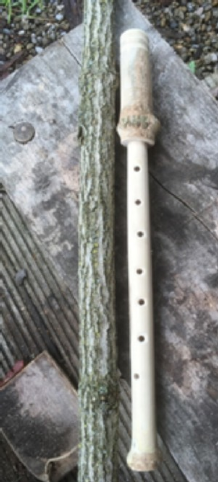
I’d also taken up the Slovak Gajdy with its double reeded chanter. The reeds in my Gajdy made by Juro Dufek, are composite, a nylon body and carbon fibre tongue. As I learned to play these bagpipes I also learned a little more about single reed behaviour and tuning, although the materials in these reeds were much more resistant to moisture and therefore more stable and less problematic. On the other side of the coin, in return for helping a Bulgarian friend of mine move house, I was presented with a wonderful Kaba Gaida, the Bulgarian bagpipe of the Rhodope mountains. The beautiful deep voice of this bagpipe is produced by reeds made from Elder. This bagpipe was set up for the climate in Bulgaria as opposed to North East England. There now began a new phase of reed fettling, with reasonable success as long as the pipes were played regularly. Finally, to add to the background of my interest in single reeds, I’d wondered, when playing at historical events and presenting a portrayal of a bagpiper from medieval England, what could a piper of the time make with the minimum of basic tools with materials readily available to hand? There was plenty of Elder growing around where I live. Could I make a bagpipe without any electrical tools, without a lathe even? The Elder chosen for all of the parts of the pipes I was to make was cut green, that is to say, it wasn’t stored and dried for a period of time. Perhaps, better results would happen if the wood was seasoned, Fujara makers cut their branches in the Winter, but part of what I wanted to do was to make something to play a tune on that had just been foraged from the hedgerow or woodland.
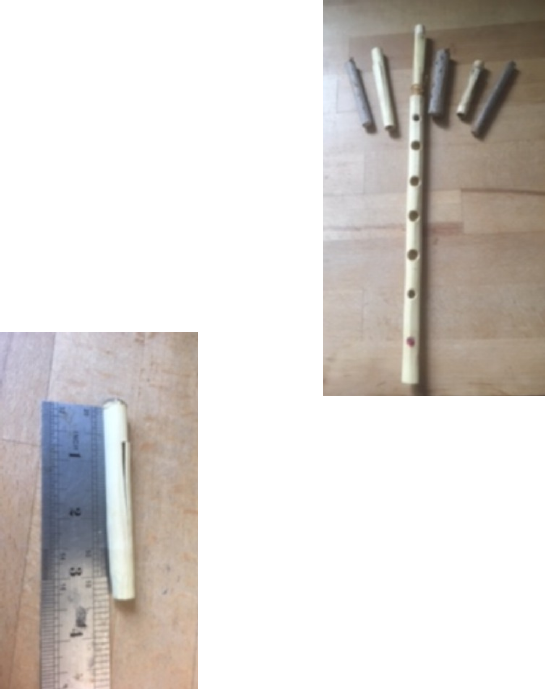
To make a reed;
The sizes can all be altered as the pipe is made to fit the reed, this wasn’t a scientific experiment, but an exercise of trial and error to simply make something that would play a tune. In the end I made reeds of various sizes, but below is a typical size that worked well in the final bagpipe.
….. here’s an example (below);
Cut a half inch diameter piece of Elder 3.5” long and scrape off the bark with a knife. Using a thin rod, needle file or drill bit, clean out the pith to produce a clean hollow tube. Block off one end with wax, (Babybel cheese wax works very well, and comes in handy to tune the chanter).
With a sharp knife or a very fine modelling saw, make a downwards cut into the reed half an inch from the blocked end. You are now about to make the tongue of the reed. When doing this step with Arundo Donax, Spanish Cane, it’s possible to lever the tongue and create a running split along the body of the reed. I found this not too work well with Elder, so made a guide incision with the point of my knife where I wanted the spring of the tongue to run.
Now is the tricky part of making the reed sound. This will involve careful cutting and scraping of the top of the tongue and springing or setting the reed by lifting the tongue and letting flick back to the body. There are more detailed instructions and videos on YouTube and elsewhere on the Internet of the process of making single reeds from cane and other materials, the method being more or less the same.
Once the reed is producing a strong tone without shutting off its time to make the chanter.
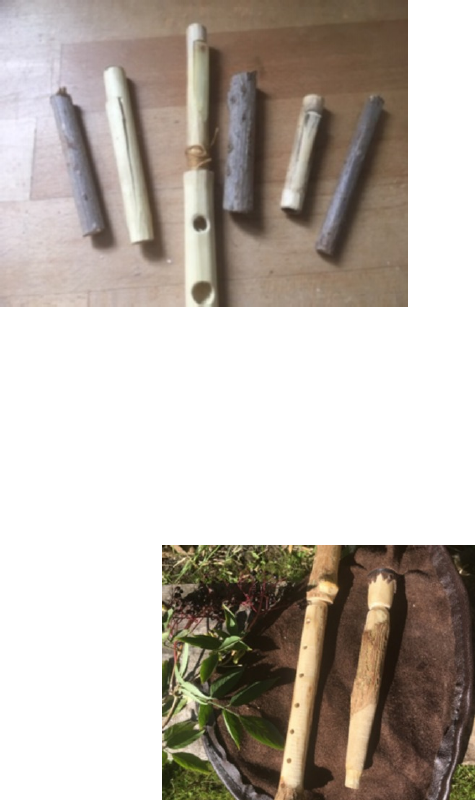
The Chanter
The simple aim of making the chanter was to come up with something which when fitted with the reed would play a usable scale that sounded pleasing to the ear. I ended up making five different chanters, the first ones have since been scrapped and put on the fire, as further experimenting with tone hole size and chanter length made them unplayable. The positioning of the tone holes was made by just laying my fingers on the selected branch chosen for the first chanter. I held the soon to be chanter in my hands in a comfortable playing position and decided that was where I’d drill the holes.
This method actually worked, and through altering the diameter of the tone holes, a chanter and reed combination turned out that played a scale and did the job. The later chanters where slightly different, in that I wanted to standardise the dimensions so as to make the reed and chanter easier to reproduce. Below are the dimensions of the final chanter which became a bagpipe and was played in my concert, The Medieval English Bagpiper, at Medieval Music in the Dales, September 2018.
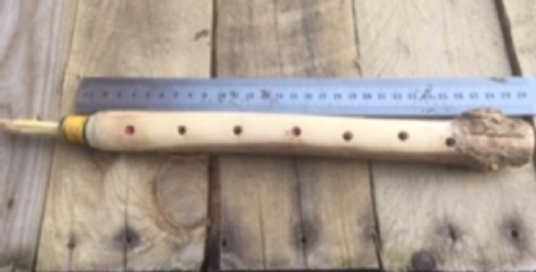
Outside diameter 28mm Overall length 293mm Bore 8mm Tone hole 6mm Distance between tone holes 35mm
To make the chanter cut a piece of elder branch to length, using a knife remove the bark to suit your own taste, I always left some on as well as the natural bumps and features of the wood. A lathe (Pole, or Electric) could be used to clean up the outside at this stage and make the chanter cylindrical. I did this with the last chanter but is not at all necessary. Drill out the pith to create the bore, the drill follows the pith so this is easily done. If you want to be really old school, poke out the pith with a rod and make your reed to suit the finished bore! Drill the tone holes. The last chanter I made had pretty much equally spaced tone holes, and with the help of some wax for tuning produced a good sound..
The Bagpipe
This was the finished chanter fitted to stocks on a hand stitched leather bag. The blowpipe, stock, and chanter stock where made using only a knife and brace drill. The fit wasn’t exact and more wax was used to seal up leaking joints as can be seen in the photos and videos. Nonetheless, even though it wasn’t the most airtight bagpipe I’ve played, it did the job and probably with more practice and several attempts a much more accurate job could be done with hand tools only and without a lathe. Of course, if a lathe is available, and this could be a pole lathe as well as an electric one, the accuracy and quality of the joints in the stocks would be much greater. Next…….. This is as far as I’ve gone with Elder pipes, although I thought about options for a drone, or perhaps a double chanter, this as yet hasn’t been tried. The reeds are quite susceptible to moisture from the piper’s breath, and the intonation begins to creep after playing for even a short time. Bellows would remedy this, as is quite often the case with the Dudy and Gajdy. Perhaps having several reed pipes to hand, the piper could easily swap to a new one with a dry reed?
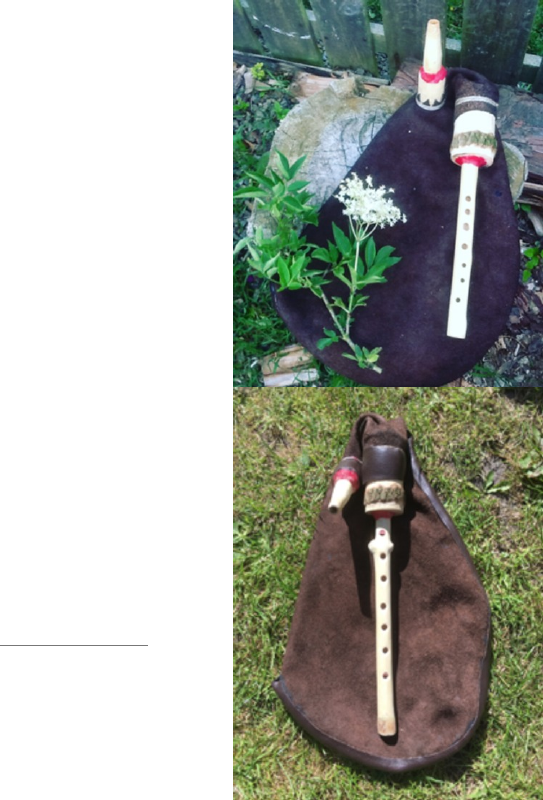
Elder grows commonly in the British countryside, so why not try to make your own, just remember to ask permission of Mother Elder before you cut the branch…….
Videos of various Elder pipes can be found on my Youtube channel Dunholmpiper. You Tube links
http://bit.ly/Chanter66
Editor’s Note: I have (half-jokingly) suggested to Paul that we set a challenge for Society members to come to the Blowout in 2020 playing examples of elder bagpipes they have made. Are you up for the challenge?!
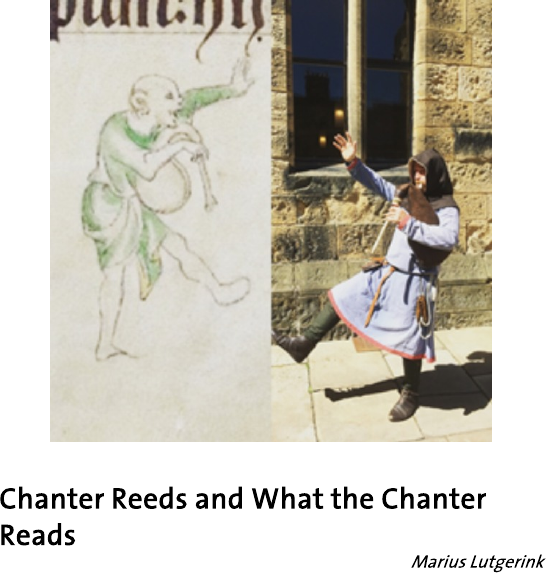
Chanter Reeds & What the Chanter Reads - Marius Lutgerink
For many years now, from the late ‘80’s on, I have been making cabrettes, the bagpipe so intimately related to the Auvergne region of France but whose origins are, beyond any doubt, to be found in Paris during the second half of the nineteenth century. Over the course of time I have been recognized as one of the major makers of this instrument, not so much because of my woodworking abilities, which are far from flawless, but basically for my reed making talent. For almost 15 years I have been giving workshops in cabrette reed making, mainly in France, that have not gone unnoticed. Based on my personal experiences, supported by the appreciation of many cabrette players, I concocted a little booklet (i) about the manufacturing of cabrette reeds. This explained not only practical dimensions to be respected but also tried to explain these as a result of broader social circumstances related to the time the cabrette was created, or developed as some prefer to say. Apart from cabrettes, I have also undertaken, to a far lesser extent, the manufacturing of chabrettes, a most remarkable small bagpipe thought to be related to the Limousin region of France. These also received much praise and appreciation, mainly for the same reason. I therefore think that it is not too exaggerated to say that my reed making skills have risen above the level of dilettantism by any standard. The main content of this article will thus rely on my personal experiences and, since the conclusions are rather unique, there is for the time being little or no scientific literature to support my findings explicitly. Still, they seem worth sharing with anyone who has a sharp eye and a trained ear.
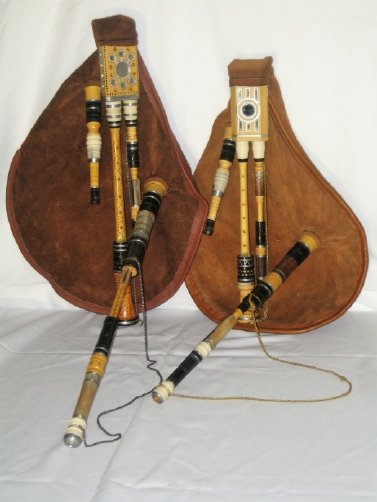
The chanter of the chabrette (photo 1) consists of three parts, the main body that carries the fingerholes, the lower one being actuated by a two-part key, a barrel to protect this key, and a separate bell joint that has two, sometimes four, tuning holes. From the very beginning I noticed something quite remarkable: the spacing between the fingerholes, for any given chanter, is constant. Each hole has an equal distance to the next hole. And what is more, each hole has the exact same diameter. That means that the maker of these bagpipes must have known beforehand where to drill the fingerholes. There is no room for trial and error. How did he (or she, but only male makers are known to this day) establish their relative position? There must be some rule to it and a very complicated rule seems unlikely. After quite some measuring and comparing, I found that the distance between the fingerholes equals 1/12th of the length of the main body of the chanter.(ii) This part of the chanter alone, with all the holes closed, including the keyhole, gives the same note as the chanter with the bell joint attached and the keyhole uncovered. So, the length of the main body determines by itself the pitch of the whole chanter. It therefore seems justified to take this main body as a starting point for measuring. But then, dividing by twelve? When I expressed my amazement to the late Thierry Boisvert, he answered laconically: “Well, yes, that is quite normal !” Normal? How so? The chabrette, he explained, belongs to an epoch when people counted by 12. One “pied” was composed of twelve “pouces”. Dividing by twelve in that time was as natural as is dividing by ten in our days (continentally speaking, that is). So, living with and working according to a duodecimal system has direct consequences for the creation of such precious objects as are chabrettes.
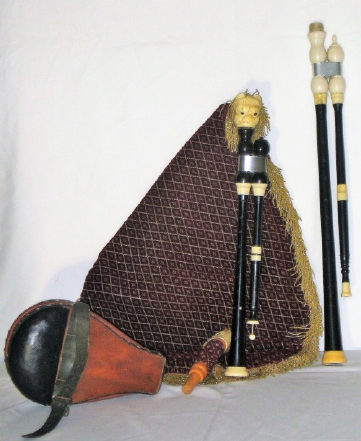
The cabrette, as I said before, dates from the 19th century, more or less the second half of it (photo 2). By this time, in France, they had had their famous and famed Revolution. One consequence of this Revolution was the abandonment of a lot of things which reminded people of the pre- revolutionary period, including the duodecimal system which was then rigorously replaced by a much more “rational” decimal system. Do we find, then, any traces of this decimal system in the cabrette? I learned to make cabrette reeds with Jean Bona, from Pleaux, at the time (he has retired long since) a respected cabrette player and maker of reeds. He taught me that, to find the length of the “canon”, (the staple, the small conical tube to mount the reed blades onto), you have to divide the length of the chanter by 10 (there you have it!), and then to add some millimetres to that; a few for shorter tubes, a bit more for the longer ones. Now that is a pity, we were on the track of something interestingly systematic, dividing by ten, but then this adding of some length to what we found spoils the fun. And why not the other way around, say like adding some millimetres for shorter tubes and much less for the longer ones? Here we lose the logic. And the manufacturing of the cabrette chanter is characterized by rigorously sticking to some very simple dimensional requirements, so one would expect that reed making must be governed by similarly straightforward rules. And it seems to get even worse. Finally, I found that if you divide the length of the chanter by 9, (yes, by nine!), there is no longer need for adding anything at all. But how does this dividing by nine follow from a decimal system? Here another observation comes into play, something I discovered long before then but without giving it much thought.
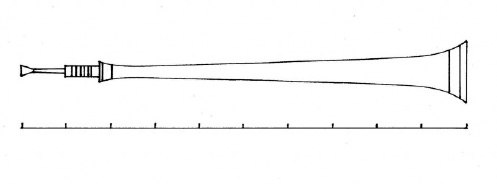
The length that the reed protrudes from the chanter tip, once put snugly into the reed socket, equals the length of the reed staple, that is, 1/9th of the length of the chanter. So, we have a complete acoustical system, the cabrette chanter with its dedicated reed, that consists of exactly ten units, ten parts, nine for the chanter length and one for the protruding reed length (photo 3). This now does fit seamlessly into a decimal way of thinking. And, of course, I checked this with all the sizes of cabrette chanters that I make (which, I must emphasise, are all copies of old instruments), from 32cm up to 54cm, and they all seem to obey to this same, simple logic. There must, I dare say, be some truth in it.
Chabrette reed making, on the other hand, has always been much more of a challenge. Here again, I make only copies of old instruments but since the
“secrets” of the appropriate reeds are lost in time, I really had to push my reed making skills to the limit. Usually I arrived at something that worked satisfactorily but I never felt convinced of having found anything comparable to the systematic approach I witnessed in the cabrette reeds. Making a chabrette chanter implies a lot of work, so how could a maker in those days know that this be not labour lost? He must have been assured beforehand that his efforts will not turn out to be vain. And, as I pointed out earlier, there is something very systematic in the positioning of the fingerholes, so one would expect a likewise systematic approach for the manufacturing of the chabrette reed. I really tried all sorts of things but they never turned out completely convincing, mainly because I was unable to find anything systematic.

When I was invited to give an informal lecture on reed making in the lovely village of La Puebla de Híjar, in Aragón, Spain, not far from Teruel, I felt that I had to come up with something more interesting, which had a wider implication than with just cabrette reed making. There is, today, something very consistent in the dimensioning of the cabrette chanter bore. The narrowest bore diameter always measures around four millimetres. From there the bore tapers out to 12 millimetres, along about three quarters of the total bore length, not considering the little taper for the reed socket, the remaining quarter being occupied by the bell, the “pavillon”, that opens up to roughly 24 millimetres at the bottom of the chanter. And this holds for any size of cabrette chanter, long or short. That means that the bore for a short chanter is opening more rapidly than the bore for a longer chanter, arriving “sooner” at the fixed diameters. So, every size of cabrette chanter demands its specific conical reamers. Changing the length of the staple is a way of adapting the staple taper to the cone of the first part of the chanter bore. That is what I thought. And how wrong one can be!
In measuring old chabrette chanters I noticed that, contrary to the cabrette, the bore taper of the main body did not change in relation to the length, the size of the chanter. It remains constant. With only one tapered reamer you can make any size of chabrette chanter. Ah, but that then would mean that the length of the staple need not change according to the size of the chanter, this staple length remaining the same for any size chanter. Now that could be an interesting subject for my lecture! I could hardly wait to put this brilliant idea to the test. And it failed hopelessly. Whatever I tried, nothing really worked as it should do. Dull sound, false notes, disappointment all over the place. But in trying all those different reeds I seemed to notice that the taper of the reed staple was, other than I thought, of no great importance as long as one stayed within reasonable limits. If ever there were a slight difference in timbre, in tone colour, I was unable to notice it. So, if it is not the taper that counts, then it must be the length of the staple. But how might one determine this length? Many trials followed, to no avail.

And then I remembered what has led to such great results in the case of the cabrette. There I divided the length of the chanter by nine, that is the nominal number of the numerical system in use at the time minus one, to calculate the length of the staple. This eventually gave an acoustical system comprised of ten units, the nominal number of the decimal system. So, what if I did the same for the chabrette. We already found reasons to believe that the chabrette belongs to a period where a duodecimal system was widely and perhaps exclusively used. What now if I divide the length of the whole chanter, the main body with its bell joint attached, by eleven, twelve minus one, to find the length of the staple? To my surprise, relief and, above all, great pleasure, it gave the proportions for the perfect chabrette reed. Divide the length of the chanter by eleven to find the length of the staple, attach a vibrating part to it, of dimensions to your taste, and there you have it, a faultlessly functioning chanter. That’s all there is to it! And not only all the notes are now in tune, they are easy to obtain, no hard work needed, the sound quality changes from rather timid to quite present, without deafening the ears, very much in keeping with the visually luxuriant appearance of the instrument, and there all of a sudden is a diminished fifth that is perfectly playable. It feels like the instrument finally sounds like it is supposed to do, just because of the carefully calculated length of the staple. Calculation that complies perfectly with the duodecimal system supposed to be in use at the time of the making of this bagpipe.
The better a new theory, or hypothesis, is in making predictions, the more it might be regarded as validated. Does this “new” hypothesis effectively make any predictions? Jean-François “Maxou” Heintzen, probably one of the most dedicated researchers of French archives of our days, seems to have discovered no less than four generations of one family, the Aujay family of Hyds, Allier, central France, who were bagpipe makers (iii) Presumably they made the type of pipe now known as “Cornemuse bourbonnaise”. These were lavishly decorated with intricate pewter inlays of very high standard, often incorporating, so it seems, monarchic or imperial symbols like crowns or “fleurs de lys”, but sometimes probably religion based tokens like a monstrance or a chalice (photo 4).(iv) They are supposed to date from the late 17th up to the 18th century, again a period where the duodecimal mode was the prevailing numerical system in France. These bagpipes are nowadays considered strange to our modern musical taste, difficult if not impossible to call to live, and more adapted, if ever, to a rather exotic kind of musical scale, that does not really flatter our ears. Defective is the word that comes to mind. Impressed as I was by their visual appearance, I have never been able to retain myself from making, much simplified, copies of these old pipes. For years, four or five prototypes wandered around my workshop, taking up space. You know, the kind of things you bump into from time to time, saying to yourself: ‘Oh, there you are again, what to do with you?’ And I was never able to make reeds for them that sounded more or less right. This “more or less right” merits an article of its own, but suffice it to say that one would expect a minor third, counted from the fundamental note, in a cross-fingering configuration (no extra holes needed) and notes in the higher octave up to a minor third as well. And of course, since we’re dealing with a Western European musical instrument, one would prefer to have a semitone below the fundamental, and not the whole note, Scottish style. Whatever I tried, I never had all of it. The semitone was not so hard but having a minor third and ease of overblowing seemed mutually exclusive. Either one of these were possible, but never both of them. Until, yes, until I decided to divide the length of the chanter by 11, the nominal number of the numerical system in use at that era, minus one, to calculate the length of the staple. All of a sudden I had it all, all the notes are present and in tune, minor third, diminished fifth, even a usable diminished second, and overblowing presented no problem at all. And what is more, I had, quite unexpectedly, a magnificent sound that merged perfectly with the drones. Just by calculating the length of the staple according to the numerical system “en vigueur” one discovers without the slightest hesitation the musical riches of these old bagpipes. With just a simple gesture they spring to life, and what a life that is! The only drawback seems to be the major third, that is slightly low with the now usual fingering, the index finger placed and the ones below it all raised. If, however, one closes at the same time the hole for the little finger, then this low major third is raised to a perfect one. This fingering is positively supported by written documents (v) and not unusual for other types of bagpipe as well. So I see no problem here, it’s only a matter of getting accustomed to it.
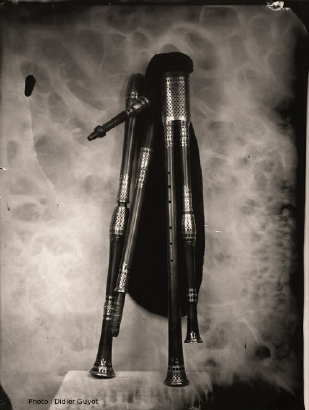

Allow me, I pray, a short digression on this too low major third, this “neutral third” as some people like to call it, especially when talking about cabrettes. It seems to have itself established as a particular musical phenomenon, giving rise to the most imaginative and imagined hypotheses. These all have one thing in common. They seem to completely, and willingly so it appears, ignore the fact that the cabrette is a product of the later 19th century, within a social structure as mundane as was Paris at that time, and thus they make no reference to its implications. Paris was, and still is by the way, a modern city with all the benefits and disadvantages of modern life, including a more and more standardized musical taste. I find it highly unlikely to imagine a cabrette maker in this worldly Paris town, making a bagpipe based on microtone scales, or bardic ones, or whatever scale that sounds weird to the ears of his neighbours, and hoping to sell this instrument to some customer that is not as yet prepared to see himself expelled from serious music life. And a bit more technical: there are about ten (10! nothing to do with a decimal system, though) different fingering configurations that might give a third of some sort. Among them is a perfect minor third, and a perfect major third, in any tuning of your taste. Selecting any one other than these as a basis for a musical theory seems slightly far-fetched to me, or as they would say in French: “capillotracté”, drawn by the scalp. Of course, using a “neutral third” in order to have your style of playing appreciated by a specific audience is quite another matter, more of cultural than of musical interest. So far for this little digression. Apart from carefully calculating the length of the staple, I make my cornemuse reeds rather by guesswork and, by golly, I have not yet been able to establish a relationship between the length of the staple and the length that the reed protrudes from the tip of the chanter, as I did do in the case of the cabrette. Some reeds, mounted in the chanter, seem to come close to this length, others are quite far off. Some research remains to be undertaken in this domain, but it is reassuring to know that one will be rewarded with an astounding quality of sound in a most impressive bagpipe.
(i) Marius LUTGERINK: *Le Bouquin, ou l’art de faire les anches de cabrette en toute confiance, *published by the author, contact: mariuslutgerink@hotmail.com
(ii) For more details, see Marius LUTGERINK: ‘Chabrettes, cabrettes, musettes. Combien de divisions?’ Pastel, 57 (Toulouse: Conservatoire Occitan, 2006/1), pp.26-29
(iii) http://bit.ly/Chanter67
(iv) Copy, made by Nicolas GALLEAZZI of Clermont-Ferrand of an old bagpip. Art photo by Didier GUYOT
(v) Among others, Lucien GUILLEMAIN: Méthode de cornemuse, l’amicale de Bas-Berrichonne; 1950

Tools of the Trade: The Octogonalizer - Mike York
I have been lucky enough to work in the workshop of Jon Swayne for the last 19 years, which is very well equipped with not only commercially bought tools and machinery but also specialised jigs and devices that Jon has made over the years to make the tasks of repeat production and consistency all the more convenient. The division of labour in the workshop is such that my efforts on “the production line” afford Jon more time in the research and development side of things, as such the majority of these jigs have been designed and made by Jon and not myself. So when Jane approached me to write about my favourite jig that I used in the workshop, although there were many ingenious candidates, I felt like I should present something that I had some part in the creation of. The item I have chosen was largely my idea, though built by Jon initially, I have rebuilt it myself several times on the occasions it has fallen from its home on the very top of the bandsaw! One of the most ubiquitous concerns of all pipe makers involves making square pieces of wood round. All our timber stock exists for the most part as square billets, so for example when making a G student chanter I would select a piece of wood 45-50mm square by 460 mm long and the finished instrument would end up slightly shorter, round and with a diameter of 40mm at the widest point. If you simply take the square billet and hold it in the lathe to turn it to a cylinder, not only is it time consuming, it’s very noisy, makes the lathe vibrate and is slightly frightening as the sharp 90-degree corners of the piece whiz past the gouge at roughly 3000rpm. It’s much quicker and more convenient to cut the corners off first using a bandsaw to create a friendly octagon.
For many years our method for doing this was to hold the diagonal of the square billet perpendicular to the table of the bandsaw, a piece of wood cut to a right-angle triangle would be held under one face of the billet in order to maintain this angle. The adjustable steel fence, which sits on the far side of the blade would then be set by eye to determine the width of the cut which would best result in an octagon. This is best understood by looking at Fig 1 - 3 As you can see there are a lot of fingers and thumbs involved in holding this rather unstable arrangement together, not least because the downward force of the moving bandsaw blade wants to rotate the billet clockwise (from the observer’s perspective) away from the triangular supporting piece. This rotational force most often expresses itself by the blade grabbing the billet very suddenly, if you have a loose grip on the billet its more likely to happen and it’ll be taken from your hand with a loud bang. The tendency is to keep a firmer grip on the piece, the downside of which is that if you’re still unlucky enough to fall victim to this mischievous force then your hand will move with the billet, in the direction of the blade. Then if you imagine the billet we are working with is going to become a blow pipe stock, with starting dimensions of only 65mm in length by 35mm square and you are working with your hands very close to the blade, you can begin to appreciate how dangerous this method is. In fact, putting this in writing I can’t believe we actually did this for so many years. Obviously the first cut is the worst because the billet is resting on one of its corners, once you’re onto the second cut you at least have a narrow flat face resting on the table, but its still far from fool proof.
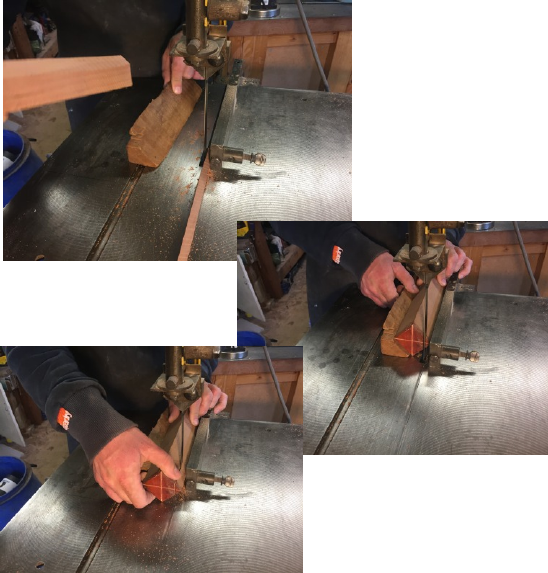
Fig 1. The right angle triangular piece of wood that is used to support one face of the billet.
Fig 2. Starting to remove the first corner of the billet
Fig 3. As the cut progresses the right hand steadies the wood on the far side of the blade
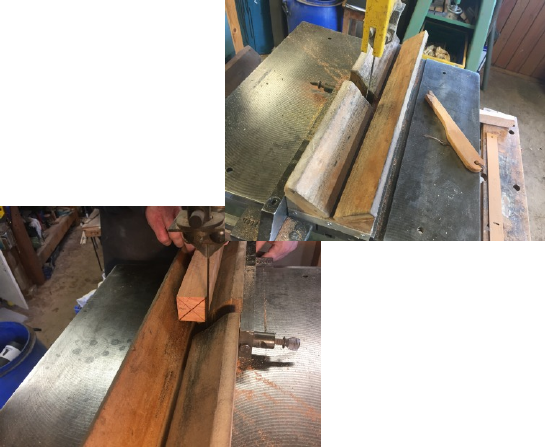
Eventually the inevitable happened involving a loud bang, pain, swearing, blood, a trip to West Mendip hospital and a bandaged thumb. Luckily the thumb made a full recovery after a number of weeks, but I vowed to make sure this incident was never repeated and set about pondering a relatively risk free alternative… The Octagonalizer (fig 4) is essentially an MDF V-bed which cradles the billet at the correct angle. It has a section removed to accommodate the blade and has a pair of rare earth magnets set into the side face which engages with the steel fence. As before you adjust the fence (and hence the position of the V-bed relative to the blade) to determine the width of cut. It wasn’t until I had been using the Octagonalizer for some time that I realised it was possible to set it very easily to the exact width of cut required to produce an accurate octagon. This is achieved by first holding the square face of your billet perpendicular to the blade and adjusting the position of the V-bed til this square face is resting against the blade (fig 5).
Fig 5. Adjusting the position of the Octagonalizer relative to the blade to achieve a cut that will result in a fairly accurate octagon
Fig 4. The Octagonalizer and pushing stick, the left hand side of the Octagonalizer is attached to the steel fence with rare earth magnets
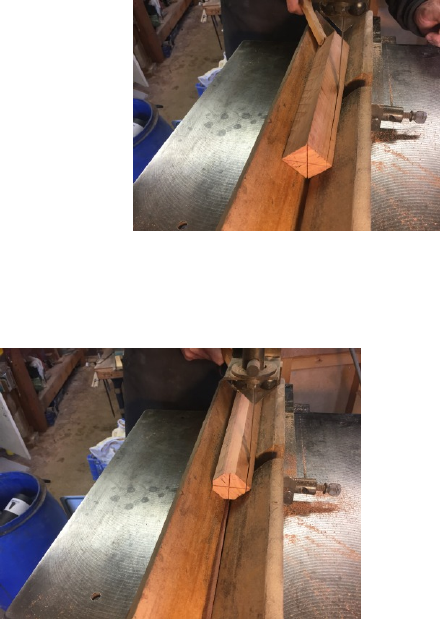
Obviously, the main advantage of this new system is that the billet is held firmly in place throughout the cut and the downward force of the moving blade is resisted by the side of the V-bed closest to the blade. This means you can push the billet past the blade with a stick and keep your hands and fingers well out of the way (fig 6). The added advantage of being able to easily make accurate octagons is more time efficient when it comes to turning and also makes it much easier to start with billets whose dimensions are closer to those of the finished piece.
Disclaimer: This article is entirely fictional and for entertainment purposes only. Please do not try any of the activities detailed herein at home, the author accepts no responsibility for any harm that may befall persons attempting to octagonalize wood or other materials.
Fig 6. Taking the first cut….look no hands!
Fig 7. The final cut
Review: The Long Century by Dave Rowlands (book) - Richard York

The Long Century, One Piper’s Odyssey through the 18th Century Drawing Room. Collected and Edited by Dave Rowlands, 2018
This review comes in two parts.
Part the First: Buy it.
Part the second: More information and discussion, leading to the same recommendation.
As the introduction explains, Dave Rowlands started by investigating music played in places from the stage to private parties and taverns between 1700 and 1830. Rowlands looks at a wide range of manuscripts, and presents his favourite bagpipes-friendly tunes with a wealth of comment and period illustrations. The book is set out mainly for players of open ended low D chanters with extended range, but playable, he says, by lowland and border pipers able to pinch into the upper register. Two personal confessions are now due: Firstly, I’ve still not played all the tunes in this book. I look forward very much to so doing, meanwhile I’ve dipped into it throughout its length – pages 25 to 98 bring enough tunes to keep a player happy for a long time. So there are bound to be gems I’ve not spotted. Secondly, changes in my hearing in recent years mean, sadly, I now play those open ended pipes far less than before, so I haven’t road-tested as many tunes as I’d like on them. But playing many more on a variety including Northumbrian Smallpipes, hurdy gurdy, even wire-strung harp, and a few other things shows they’re also very happy on many instruments. Northumbrian Smallpipes, although, (if this worries you), strictly speaking too modern in their keyed form, are well suited for most, this being an era of tunes with plenty of jumps over the octave break. Incidentally, I also tried a couple, including Mozart’s Deutsche Tanz no.2, better known to us as Michael Turner’s Waltz and complete with attractive second line, on my local NSP group, and they make good sociable tunes too, as well as Rowlands’ intention to present performance pieces.
The introduction is quite long, but very readable, discussing music sources, the likelihood of these tunes having widely been played on the Pastoral Pipes, (which of course would have managed those wide ranges and jumps well enough), more about where they were played, discussion of whether they can be called folk music, or even if folk music exists at all, and still more, ending with philosophy and quoting both Descartes and Kant. Rowlands uses his experience in art education to good effect in choosing his picture sources too.

The tunes start with a short selection from two stage productions where music is integral to the script, and with strong piping references, The Beggar’s Opera and The Gentle Shepherd. “One Evening having lost my Way” opens, which he describes bravely as “annoyingly familiar”… it reminds us how popular music shares itself round, with tunes from Playford reappearing here, then, as in this one’s case, going on into the Morris. If you know “Jockey to the Fair” from various traditions, you’ll recognise this straight away. On the same page, “Le Printemps Rappelle aux Armes” does, as he says, make a fine bourrée, both on pipes and gurdy.
I’ll not give a blow-by-blow commentary of all, but of the next two pieces, “Bonny Gray-Ey’d Morn”, ( full set of words supplied), exemplifies a number in this book which for me stand alone well, but call out for the addition of some tasty chords on a cittern or similar, to drive them along; then the wonderfully named “Grim King of the Ghosts” typifies the popularity of so many in their time. Rowlands doesn’t mention this, but Claude Simpson’s “British Broadside Ballad” tells me that it appeared in no less than ten ballad operas. It’s worth noting that you really need to be comfortable playing top Eb on the D chanter to make this one work, likewise a number of others in this collection. Together with the need to be very confident at jumping over the octave break, it’s not a beginner’s book, but one with material to satisfy more advanced players, though some tunes are technically simple enough. Some here, like “The New Highland Ladie” [sic] are a lovely slight twist on things you thought you knew well. Some, like “Shins about the Fire” allow you, as he rightly says, scope to improvise, with its B music a bare bones structure just waiting for embellishment.
Many of the tunes come with variations, so beloved of the period. He even presents a pleasing set of his own, to encourage us to try this creative path. One set which really grabbed me was “ ‘Jenny’, a New Hornpipe”. It’s a great tune to start with, but in several of the variations there are rhythmic and melodic twists which brought me up short with pleasure. It would work well at various speeds.
Of course there are bound to be some tunes among so many which may seem more workaday, though no doubt they’ll be other players’ favourites, so I’ll not name any! I do like that some pages are presented so that playing straight through makes a good set, so on p66 we have “New Drops of Brandy” (which is good fun), into “Smack of the Whip” and “Kick the Rogues Out”, all 9/8 tunes running well together.

As I said, I tried some tunes on various instruments, and they’re very adaptable. I got waylaid for ages by page 82, where “Blodeu’r Drain”, (‘Flowers of the Thorn’), is gorgeous and I was lured into making keyboard arrangements for it. Next comes “If the Cat had Gold”, from Edward Bunting’s “Ancient Music of Ireland”, so of course I had to visit our edition. It’s maybe not widely known to pipers and all strength to Rowlands for finding pipeable tunes in there: Bunting collected from the last surviving wire strung harp players gathered in Belfast at the end of the 18th Century. It’s a good thing he did and by publishing them for the drawing room he ensured these tunes’ survival. Just, if you have Bunting, I beg you, please don’t try playing Bunting’s own nauseatingly saccharine arrangement! I was kept very happy for quite a while arranging it for my own wire strung harp, or I might have spent more time checking other tunes in Rowlands’ book. Thanks to Dave R for bringing it to my attention, along with some in James Oswald’s collection, another in which I find gems but have yet to work right through.
So it’s a book of plenty, with a lot of very appealing piping tunes, many,
in true leisured 18th Century fashion, inviting you to spend time exploring and developing them, and for those who play other instruments, scope to enjoy diverting onto these as well. And all topped off with “Keane’s Leaving Tune”, a fine and completely appropriate farewell to this collection.
See Part the First of this review: Buy it!
http://www.lulu.com/spotlight/daverowlands Price is quoted in $ but will convert to £
Across the Water - 18th Century Music from the Near Continent (book) by Dave Rowlands - Jane Moulder
Since The Long Century was published, Dave has not been idle and this companion volume came through my letterbox. I have not had time to post it out for review - so I will simply copy out a few notes from Dave’s introduction. The book contains tunes from manuscripts and published sources from France, Wallonia and Germany
“Unlike The Long Century, this was not be any kind of semi-scholastic work, linking music to a theme, it is a snapshot of what was being played and collected by musicians during the same period covered by the Long Century. It is obvious that the selection presented is a personal selection, drawn from some of the very many available collections, and must be treated as such. It is not “the best of”, just “my best of”. A companion volume to The Long Century to be experienced, enjoyed and to hopefully spur players to go and search for more themselves.
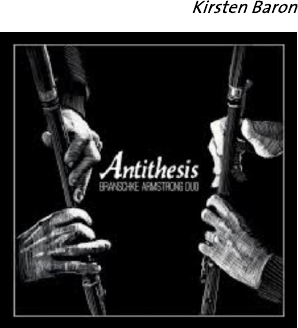
Review: ‘Antithesis’, Branschke Armstrong Duo - Kirsten Baron
First, let me point out that in spite of their initials, the Branschke Armstrong Duo are not at all BAD. On the contrary, it doesn’t get much better than this: the CD is a firework of bagpiping, and bagpiping only. As both musicians push their D border pipes well beyond the limits of convention, the absence of other instruments is no problem; one of their favourite tricks involves stopping the drones to create texture, contrast, and impressive percussive effects.
Out of the nine tracks onthe CD, eight were written by CallumArmstrong, who is one of the most exciting young composers on the scene right now. Not just on the folk scene, or the bagpiping scene, either - his tunes mostly defy genre and classification. They are characterised by an immensely joyful energy, musical intelligence and a sly sense of humour. My favourite piece is probably the wide-awake, energetic stop-and-start of ‘Sleepy Summer Lanes’.
My other favourite is Matthias Branschke’s delightfully titled ‘Das Jahr des springenden Häuptlings’ (The Year of the Leaping Chief), a percussive, thrumming, playful piece with great drive and energy.
Callum and Mattis are both technically amazing players, but what makes their music unmissable is that the instrumental pyrotechnics are always employed in the service of creating something beautiful, witty and enjoyable (and often also quite danceable). Their playing styles match beautifully: sometimes one player provides percussive underpinning while the other carries the soaring melody, other times their two voices entwine or twist around one another in complex duets.
I had the good fortune of seeing Branschke & Armstrong perform some of this material up close last year - quite breathtaking - do catch them in the act if you get the opportunity!
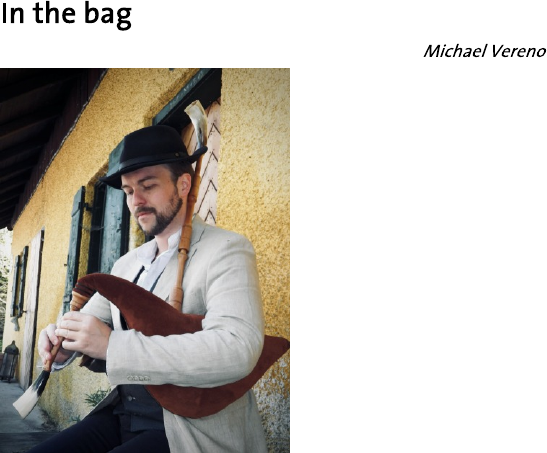
In the bag - Michael Vereno
Michael Vereno was born in 1986 in Salzburg, Austria. He has been playing several bagpipes since childhood, with his main focus being on Central European piping traditions of Bavaria, Saxony, Austria and Bohemia. He holds a doctor’s degree in Linguistics, having written his thesis about the etymology of bagpipe designations. Michael is an active musician and plays gigs and concerts both as a solo performer as well as with Ensemble Unisonus. He also takes part in making and developing traditional and modern Austrian bagpipes in the workshop of his wife Sonja. He lives with his family in Grödig near Salzburg, Austria.
**What bagpipes do you play?
I play various types of historic and traditional bagpipes, but my predominant instrument is the Central European type called „Bock“ in German.
**What led you to take up piping?
Since I took up piping in 1995 I had been looking for an answer to that question. I am now quite sure that it must have been a French audio cassette which featured a Berrichonne bagpipe played by Louis Soret. I listened to this recording („La ballade de Jehan de l’Ours“) up and down when I was in kindergarten, so I’m quite convinced that this was my first - albeit unintentional - acquaintance with the pipes.

**Which pipers do you most admire?
My peers are: Rudolf Lughofer, who was a key figure in reintroducing traditional piping in Austria and my teacher; Josef Rezny, the great Czech ethnographer and virtuoso piper, to whom I owe part of my piping style; Sepp Pichler, who has surely mastered one of the most extensive repertoires of Austrian pipers; Frantisek Kopsik, the Bohemian piper born in 1822, who in 1909 recorded several tunes which link us to an ancient piping style; and finally, three scotsmen - Duncan MacGillivray, who very gently and kindly helped me with my first steps on the instrument, Jimmy Mckay, and the late Tain piper Bobby MacRae, who were my teachers in the very beginning.
**Name three, non-piping-related musical influences:
Medieval music, Baroque music, various a capella folk music traditions.
**What three albums are top of your playlist right now?
Difficult to answer, because I hardly listen to playlists. I’m more like the guy who plays one album to death and then forgets he ever had it for about a month until the process starts all over again.
**If you had your life again, what instrument would you play?
I’m afraid I would stick with the pipes.
**Name your favourite music festival.
I have been participating at the biennial International Bagpipe Festival in Strakonice for almost 20 years now. This has become so much of a personal tradition that I cannot imagine not going there.
**What three words describe your piping style?
Flowers, Beer, Dance
**Bellows or mouth-blown?
Since I am a singer and like to sing along while playing, I prefer bellows. They are also a huge benefit in terms of moisture control (I only use cane reeds), but I find this to be equally manageable in mouth-blown pipes.
**Cats or dogs?
I am allergic to both, so I have no option of keeping them as pets.However, I did own a Bohemian bagpipe once whose bag had been made from the hide of a German Shepherd named Caesar. Naturally, the dog was not killed or bred on purpose for that. Dog hide was a common material for bags in Central Europe in earlier days, and Caesar happened to have an owner who honoured this tradition after the the good boy had died of old age.

**Do you prefer playing, dancing or both?
I would love to be able to dance, but I have two left feet. I am fine with making the music for dancers instead of imitating their abilities.
**Cane or plastic reeds?
That would depend on the player. Plastic or other artificial reed materials
have their advantages especially for beginners, but for a player with some routine I see no reason for not using an exceptionally fine and eco-friendly material like cane.
**What’s your greatest musical achievement?
I don’t really have one achievement I am particularly fond of, but I like to think that with every performance, even a small one, I have the opportunity to reach out to people and bring something new and interesting into their life.
**What’s your most embarrassing bagpiping moment?
There is a German pun which says “Der Sackpefiefer stimmt immer, die Sackpfeife nie” – it works because “stimmen” means “to tune” as well as “to be in tune”. So, the piper is always tuning but the pipes are never in tune. There has not been one really embarassing moment as far as I remember, but several which could have gone far better.
**What’s the most annoying question you get asked about the bagpipes?
“Are you Scottish?”
**What advice would you give a novice?
Don’t do it unless you have a taste for madness and despair, but it will
lead you into a big family of very good, kind and sweet people.
**I love bagpipes because…
… aside from being instruments which are disproportionally complicated with regards to their possibilities, they are at the same time a marvellous device of bringing people together, who would otherwise never have met. I owe many wonderful acquaintances and fond friendships to this instrument.
Front cover: Cassandre Balosso Bardin playing askomandoura with her group, Bonnendis, at the Guild Sessions in Lincoln. https://bonnendis.weebly.com/ Cassandre is the founder and director of The International Bagpipe Organisation.
(Photo Sophie L Hillman)
Back Cover: A bench end from All Saints Church, Chevington, Suffolk. Dated to the 15th century, there are also a number of other musical instruments depicted, including a shawm and double pipes. Thanks to Paul Haynes for spotting and photographing them.


From Chanter Summer 2019.
- Australia
- Austria
- Britain
- Bulgaria
- England
- France
- Germany
- Hungary
- Ireland
- Italy
- Mali
- Oman
- Poland
- Romania
- Russia
- Scotland
- Slovakia
- Spain
- Strakonice
- Togo
- Usa
- Wales
- Auvergne
- Bavaria
- Bulgaria
- Central France
- Continental
- Dales
- England
- France
- Galicia
- Halsway Manor
- Hungary
- Italy
- Le Son Continu
- Limousin
- Liverpool
- London
- North America
- Northumbria
- Occitan
- Rhodope
- Saint Chartier
- Scotland
- Strakonice
- Yorkshire
- Armstrong, Callum
- Baron, Kirsten
- Branschke, Matthias
- Burbaud, Patrick
- Faulkner, Dave
- Faulkner, David
- Haynes, Paul
- James, Paul
- Martin, Paul
- Merry, James
- Merryweather, James
- Moulder, Jane
- Moylan, Terry
- Playford
- Resta, Fabio
- Rowlands, Dave
- Swayne, Jonathan
- Turner, Steve
- Vereno, Michael
- York, Richard
- Zloch, Merit
- Data Processing Notice (GDPR)
-
@BagpipeSociety on X (formally known as Twitter)
-
TheBagpipeSociety on Instagram
-
 BagpipeSociety on Facebook
BagpipeSociety on Facebook
Something wrong or missing from this page? Let us know!
